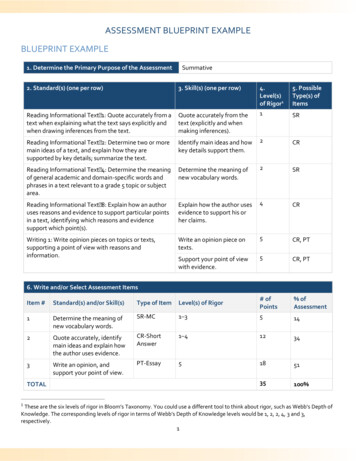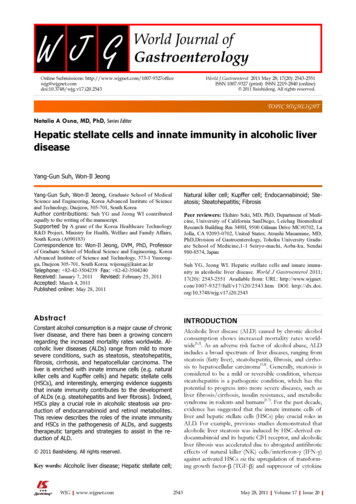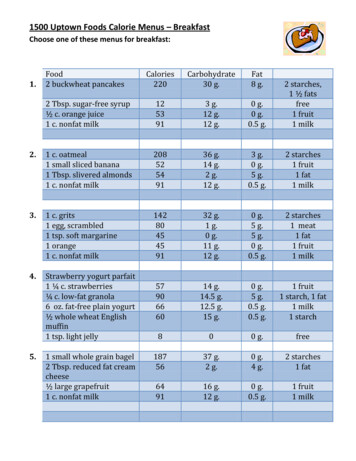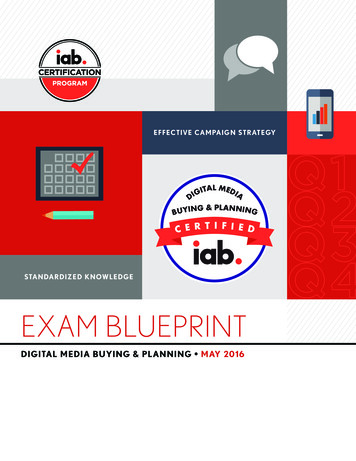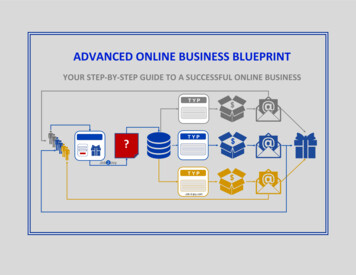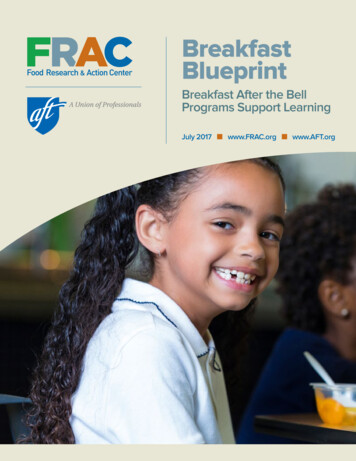
Transcription
BreakfastBlueprintBreakfast After the BellPrograms Support LearningJuly 2017 n www.FRAC.org n www.AFT.orgAFT and FRACnBreakfast BlueprintnAFT.orgnFRAC.org1
BreakfastBlueprintBreakfast After the BellPrograms Support LearningAcknowledgmentsAbout AFTThis guide was developed by Chelsea Prax at the AFT;Mieka Sanderson, formerly of FRAC, now at USDA; andCrystal FitzSimons at FRAC. AFT’s Lauren Samet, JenniferScully and Melanie Hobbs reviewed the guide. AFT andFRAC would like to thank Anna Mullen with the Farm toSchool Network and Anisa Heming with the Center forGreen Schools for contributing sections to the guide.The American Federation of Teachers is a union ofprofessionals that champions fairness; democracy;economic opportunity; and high-quality public education,healthcare and public services for our students, theirfamilies and our communities. We are committed toadvancing these principles through communityengagement, organizing, collective bargaining andpolitical activism, and especially through the workour members do.The authors appreciate and value the time AFT unionmembers and leaders contributed in support of thisguide. In particular, we thank the Meriden Federationof Teachers, Syracuse Teachers Association and UnitedFederation of Teachers for thoughtful reflections onsuccessful aspects of district programs, which informseveral case studies. We also thank the members ofAlbuquerque Teachers Federation, Houston Federationof Teachers and Spring Branch AFT who shared theirperspectives in focus groups.AFT and FRACnBreakfast BlueprintnAFT.orgnAbout FRACThe Food Research & Action Center (FRAC) is theleading national organization working for more effectivepublic and private policies to eradicate domestic hungerand undernutrition. For more information about FRAC, orto sign up for FRAC’s Weekly News Digest and monthlyMeals Matter: School Breakfast Newsletter, visit frac.org.FRAC.org2
Breakfast BlueprintBreakfast After the Bell Programs Support Learning“Every student in my class looks forward to eating breakfastin the classroom. Some students do not have time or food toeat before they get to school. Students were complaining ofstomachaches, but now with breakfast in the classroom,there is less complaining.” — Elementary school teacher, CaliforniaThe American Federation for Teachers (AFT) andthe Food Research & Action Center (FRAC) arecommitted to strategic partnerships at the school,district, state and national levels to advance children’shealth and well-being. We especially value collaborativeapproaches to address children’s food security. Oneway the AFT and FRAC work together is to ensure thatall children, especially those struggling with hunger,have access to healthy school meal programs.Thanks to the Healthy, Hunger-Free Kids Act of 2010,federally funded school breakfasts and lunches are morenutritious than ever. The law ushered in requirements thatschool meals include more fruits and vegetables, morewhole grains, less sodium, no trans fats, and limits onAFT and FRACnBreakfast BlueprintnAFT.orgnHHHA Hsaturated fat and calories. Nearly all of the nation’sschools are meeting these new, health-based guidelines.Research shows that hungry students are at a significantdisadvantage in the classroom, while students who eatbreakfast at school are more attentive, less likely to actout, less prone to becoming overweight or obese, andbetter academic performers. As documented in FRAC’s“School Breakfast Scorecard” and addressed in theAFT’s resolution “Healthy and Hunger-Free Schools,”many children miss breakfast when it is served beforeschool starts. According to FRAC’s “School BreakfastScorecard,” for every 100 low-income students whoparticipate in school lunch programs, only 56 participatein school breakfast.FRAC.org3
Breakfast After the Bell Programs Support LearningCONTINUEDWhat does the research say about Hunger’s impact on learning in the classroom?Children who are hungry are more likely to:nBe hyperactive, absent or tardy.1nExperience behavioral, emotional andacademic problems.2nRepeat a grade and have lower math scores.3The educational and health benefits of schoolbreakfast? Children who eat school breakfast:nDemonstrate improved concentration,alertness, comprehension, memory andlearning.4, 5, 6nShow improved attendance, behavior andstandardized achievement test scores.7, 8nAre more likely to consume diets that meet orexceed standards for important vitamins andminerals.2, 3, 9The operation and logistics of school breakfastprograms significantly impact their reach. Timing ofmeal service, hectic morning schedules, late bus arrivals,students’ desire to socialize with friends, the financialburden of co-payments for families who qualify forreduced-price school meals and the social stigmaassociated with participation can hinder students fromeating school breakfast. To address these challenges,schools may consider a variety of strategies, includingmorning schedule adjustments, increased collaborationwith families or breakfast after the bell programs.The “Breakfast Blueprint” is a guide focused onbreakfast after the bell programs—such as breakfastin the classroom, “grab and go” breakfast and secondchance breakfast—because they are increasinglypopular, are well-researched and have successfullyhelped schools and districts improve students’ access tonutritious foods. These innovative models shift breakfastservice from before the school bell to after, makingmorning meals available to more students. Combinedwith providing breakfast at no cost to all studentsregardless of income, breakfast after the bell eliminatesstigma and increases convenience for students.1Murphy JM, Wehler CA, Pagano ME, Little M, Kleinman RF, Jellinek MS. (1998) “Relationship Between Hunger and Psychosocial Functioning inLow-Income American Children.” Journal of the American Academy of Child & Adolescent Psychiatry, 37:163-170.2Kleinman RE, Murphy JM, Little M, Pagano M, Wehler CA, Regal K, Jellinek MS. (1998) “Hunger in Children in the United States: Potential Behavioral and Emotional Correlates.” Pediatrics, 101(1):E3.3Alaimo K, Olson CM, Frongillo EA Jr. (2001) “Food Insufficiency and American School-Aged Children’s Cognitive, Academic and PsychosocialDevelopment.” Pediatrics, 108(1):44-53.4Grantham-McGregor S, Chang S, Walker S. (1998) “Evaluation of School Feeding Programs: Some Jamaican Examples.” American Journal ofClinical Nutrition, 67(4):785S-789S.5Brown JL, Beardslee WH, Prothrow-Stith D. (2008) “Impact of School Breakfast on Children’s Health and Learning.” Sodexo Foundation.6Morris CT, Courtney A, Bryant CA, McDermott RJ. (2010) “Grab ‘N’ Go Breakfast at School: Observation from a Pilot Program.” Journal ofNutrition Education and Behavior, 42(3):208-209.7Murphy JM. (2007) “Breakfast and Learning: An Updated Review.” Journal of Current Nutrition and Food Science, 3(1):3-36.8Basch, CE. (2011) “Breakfast and the Achievement Gap Among Urban Minority Youth.” Journal of School Health, 81 (10):635-640.9Pollitt E, Cueto S, Jacoby ER. (1998) “Fasting and Cognition in Well- and Undernourished Schoolchildren: A Review of Three ExperimentalStudies.” American Journal of Clinical Nutrition, 67(4):779S-784S.AFT and FRACnBreakfast BlueprintnAFT.orgnFRAC.org4
Breakfast After the Bell Programs Support LearningCONTINUED“Breakfast in the classroom can be done properly whenall structures and routines are put in order by the school.”— Elementary school teaching methods coach, MissouriGiven the critical role school breakfast plays inchildren’s well-being and overall academic performance,the AFT and FRAC conducted research to uncover bestpractices and strategies for successfully operating abreakfast after the bell program. Nearly 600 teachers,paraprofessionals, food service staff, school healthprofessionals and custodians from California, Connecticut,Florida, Illinois, Louisiana, Massachusetts, Michigan,Minnesota, Missouri, Nevada, New Mexico, New York,North Carolina, Oregon, Texas, and West Virginiashared their perspectives in surveys, focus groups andstructured interviews. Several common themesemerged:nSchool personnel value the benefits of healthybreakfast for their students, especially the opportunityto promote social relationships and serve vulnerablechildren. They want students to have the healthiestmeals possible, and many would like to increase theuse of fresh, local, scratch-cooked foods.nTop-down implementation and non-inclusiveplanning frustrate faculty and staff. Further, theseapproaches can undermine program sustainability.School personnel wish to be included in planningand improvement processes.ncomplete all their responsibilities. For teachers,there is often a tension between the time neededto facilitate breakfast service and the expectation toteach “bell to bell.” Educators call on administratorsto provide more training and to be more explicitlysupportive of the new routines and activities that arebeing integrated into morning schedules to ensure asmooth start to the day.nFor successful implementation, many programs needresources like cleaning supplies and appropriateequipment to store, transport and dispose of foods.Based on this research, the AFT and FRAC developed the“Breakfast Blueprint.” This series offers strategies on howto plan, execute and improve breakfast after the bellprograms. We hope the content spurs constructivedialogue among typical decision makers, includingfood service directors, union presidents and schoolsuperintendents, as well as frontline staff whoimplement the programs, including teachers,paraprofessionals, custodians and cafeteria workers.States engaged for this report.WAMTMany educators are eager to share their ideason how schools can improve students’ access tonutritious foods. For example, they advocate forconsistent use of simple packaging to better servestudents with disabilities and culturally familiar itemsto boost student satisfaction among ethnicallydiverse populations.AFT and FRACnBreakfast MSTXALGANHLAFLHIFRAC.orgMOOKNMOHINWVKSAZPAIANENVAt times, the logistics of breakfast after the bellprograms do not fully account for the time requiredof custodial, instructional and food service staff to MA RI CT NJ DE DC MD VTIDAKnMENDORn Included in this reportn Not included in this report5
Breakfast BlueprintSet Up Your Program for Success“The committee supporting the new breakfast planshould include a staff person from each area of the schoolto participate in implementing the new plan and makingdecisions about changes to breakfast andinstructional time.” — Elementary school paraprofessional, West VirginiaWhen your district establishes a new breakfast after thebell program, it may be the first time that diverse staffwork together on a shared vision. They likely will bringdifferent priorities, challenges and training backgrounds.Successful breakfast after the bell programs create openlines of communication across traditional siloes, whileproviding opportunities for all stakeholders to givefeedback on ways to improve logistics.nThe district’s food service director oversees thedevelopment and execution of breakfast after thebell programs and must balance meeting the diverseneeds of schools and staff with state and federalrequirements.nLabor unions represent the collective voices ofstaff—including bus drivers, custodians, food serviceworkers, office staff, paraprofessionals andteachers—whose roles and responsibilities withinthe district can inform thoughtful planning andimplementation.nAnti-hunger advocates are often skilled at sharinglessons from other districts; they also may haverelationships with funders.nStudents and families are effectively “customers”whose input can ensure the success of innovativemenu items, meal preparation and more.Include diverse voices: Many of the surveyrespondents expressed a willingness to contribute timeand ideas to the successful implementation of newbreakfast after the bell programs, yet nearly half whoseschools had adopted a new breakfast service modelreported being “unsure” of the stakeholders whohad a chance to participate in planning, while another1 in 5 reported that only administrators contributed.Empowering an inclusive, district leadership team tooversee planning, implementation and evaluation buildsstrong breakfast after the bell programs. That teamshould consist of a diverse group of voices who will beimplementing and impacted by the program.nSchool leaders, such as school board members,superintendents and principals, are instrumentalgatekeepers who can champion the programamong families and the community.AFT and FRACnBreakfast BlueprintnAFT.orgnEmpower the team: While the food servicedirector oversees a smooth transition and a sustainableprogram adoption, the entire leadership team should beequipped with the time, space, leadership and otherresources to provide robust support, feedback andengagement. Having team members visit a school witha successful breakfast after the bell program may helpFRAC.org6
Set Up Your Proram for SuccessCONTINUEDthem build shared knowledge and learn more aboutstrategies to achieve the district’s goals. As the programbegins, the team will need to form a coherent district planthat may require flexibility for the unique needs of variousschools. As schools approach their launch date(s), theteam should conduct training and ease schools into newroutines. Finally, as the new program takes root, the teamshould determine which stakeholders are responsible forevaluating the program and adopt a structured approachto reviewing evaluation data to make improvementsand address challenges quickly.Throughout the life of the breakfast after the bellprogram, the team should work with the food servicedirector to support and guide program improvements.Furthermore, at each step, the team will benefit fromregular communication with broader stakeholder groups,both to collect authentic feedback and to report out thework of the team.A labor-management “think tank”New York City schools began to roll out a universalfashion” and “having the group think through it atbreakfast in the classroom program in the 2015-16once.” To date, the group has:school year. Several logistical challenges emerged.nCreated a hybrid service model that blendscafeteria service for students arriving early andbreakfast in the classroom for those who arriveclose to the start of class;nCoordinated adult assistance for openingprepackaged items for young students tolimit spills;nDeveloped a food service team to verify that anyschool interested in serving hot breakfast hasappropriate equipment; andnwith representatives of food service staff, custodians,Established a protocol to conduct school-basedinvestigations of challenges within 24 hours ofa report being generated, such as through theschool aides, teachers, paraprofessionals, principalsUFT’s online form.For example, school personnel were concernedabout eliminating hot breakfast service. Several ofthe city’s unions quickly realized the need to connectwith frustrated members. The United Federation ofTeachers developed an online assistance form thatenables members to request help and intervention forschool-level issues. Additionally, the union websitelists a health and safety staff contact who is assignedto directly field concerns.The unions also brought their concerns to thedeputy chancellor, who convened a “think tank”and other administrators. Over the last year, theThe New York City Department of Education alsogroup has met to review feedback from differentcreated a 33-page guide on incorporating nutritionstakeholders and troubleshoot together. One UFTeducation into elementary school lessons in thevice president reports that strengths of the groupmorning and developed a PowerPoint to guideinclude “being able to voice concerns in a timelytraining sessions.AFT and FRACnBreakfast BlueprintnAFT.orgnFRAC.org7
Breakfast BlueprintPlan for a Successful Launch“Start slow. Do a lot of preplanning so change doesn’tcome as a shock. Some may feel like, ‘I really do wantstudents to have breakfast, but I don’t know what waswrong with the old system.’ There has to be some explanation about whyyou’re changing to this new model and some recourse if it’s not working.How can folks share their challenges?”— Union vice president for elementary schools, New YorkImplementing a new breakfast service model altersdaily operations and routines for many staff, includingcustodians, food service workers and instructionalpersonnel. Without clear guidance on new expectationsand routines, many staff can become frustrated anddissatisfied. Successful breakfast after the bell programsfacilitate smooth transitions by communicating thedistrict’s intentions along with broad guidelines toparticipating schools.Develop a flexible district plan: First, choosea service model or a combination of models. (See Table1 for an overview of the breakfast in the classroom,“grab and go” and second chance breakfast models.)While weighing the benefits of each, consider the prosand cons of maintaining some breakfast service in thecafeteria. Then, draft an implementation plan that broadlyaddresses the following logistics:Timing: Many districts phase transitions, such as bystarting with elementary schools or working first withbuildings where the schedule easily accommodatessecond chance breakfast. Consider:nnCan homeroom, advisory periods or other regularelements of the schedule be leveraged?nWill bus transportation be impacted?nWhen will the program launch?Equipment and resources: Breakfast after the bellprograms usually increase the number of spaces wherefood is served. Many aspects of the school building’slayout can impact breakfast distribution, including studenttraffic, cafeteria location, number of floors, elevatoraccessibility and size, as well as classroom spacing.Assess the need for additional kitchen storage space oradditional tables, coolers or kiosks for food distribution.Maintain high safety and hygiene standards for all spaceswhere food is served by regularly distributing cleaningsupplies. Consider:nAre new equipment or supplies needed?nHow and when will teachers and paraprofessionalsreceive classroom cleaning supplies?nHow will staff members communicate the need forassistance with cleaning up larger spills?How will this impact the school day and schedules?AFT and FRACnBreakfast BlueprintnAFT.orgnFRAC.org8
Plan for a Successful LaunchCONTINUEDStaffing: Collaborate closely with staff unions to examinehow scheduling may change as student demand increaseswith a breakfast after the bell program. Consider:nWhich staff members will distribute food to theclassrooms/kiosks and at what time(s)?nWhich staff members will pick up trash andat what time(s)?nHow many food service personnel are neededand at what time(s)?nHow many custodians are needed and at whattime(s)?Training: Breakfast after the bell programs oftenrequire diverse staff to work in close concert. It isimportant that all stakeholders understand theprofessional guidelines and expectations of theircolleagues, such as the role of standardized testing inteachers’ evaluation, the federal requirements for mealparticipation tracking for food service staff, and thesafety standards that guide custodians. Consider:nWho will train teachers, paraprofessionals, custodiansand food service personnel on new routines relatedto breakfast preparation, meal distribution, wastemanagement and expectations for cleanup—and when?nWho will conduct refresher trainings or train newstaff—and how often?Student needs: Choose models and related programlogistics that account for students’ developmentalstages and capacity. For instance, older students areoften more independent and may excel with a “graband go” model, while elementary school students mayneed more assistance for breakfast in the classroom.Additionally, many special educators report that makingthe transition with minimal changes to activiti
healthcare and public services for our students, their families and our communities. We are committed to advancing these principles through community engagement, organizing, collective bargaining and political activism, and especially through the work our members do. About
